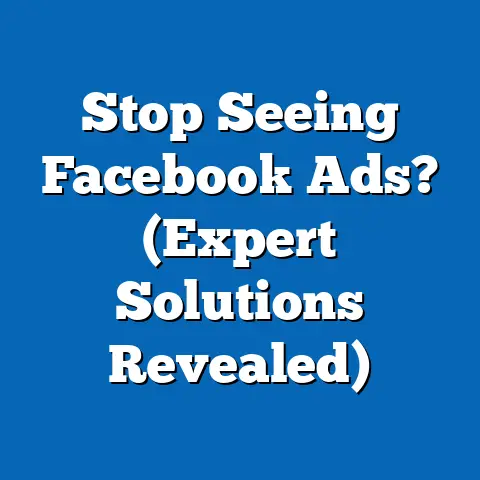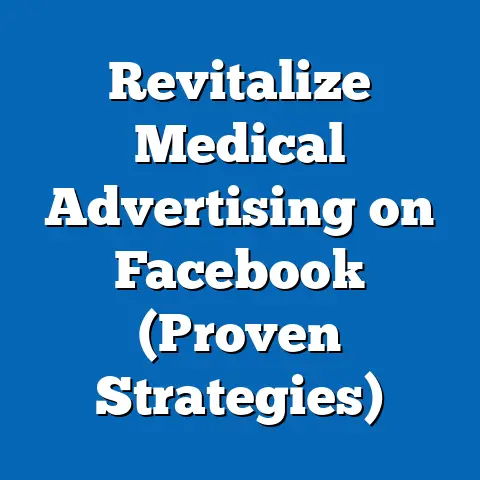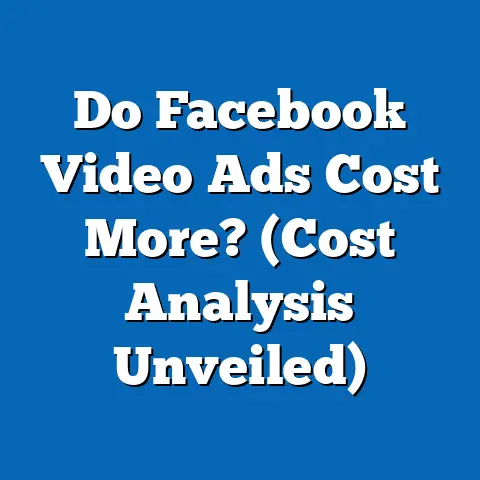Boost Brand Awareness with Top Facebook Ads (Expert Tips)
In an era where digital presence can make or break a brand, how are businesses leveraging social media advertising to stand out in a crowded marketplace? With over 2.9 billion monthly active users as of Q3 2023, Facebook remains the largest social media platform globally, offering unparalleled opportunities for brand visibility (Meta, 2023). This fact sheet dives into the latest data, trends, and expert strategies for boosting brand awareness through Facebook Ads, uncovering how businesses can tap into this vast audience to achieve measurable impact.
Facebook advertising has become a cornerstone of digital marketing, with global ad revenue reaching $114.9 billion in 2022, a 6.1% increase from the previous year (Statista, 2023). As competition intensifies, understanding demographic nuances, evolving user behaviors, and strategic ad optimization is critical. This comprehensive analysis explores current statistics, demographic breakdowns, trend analyses, and actionable insights for maximizing brand awareness on the platform.
Section 1: The Landscape of Facebook Advertising
1.1 Current Statistics on Facebook Ads Reach and Engagement
Facebook’s advertising ecosystem continues to dominate the digital marketing space, with 10 million active advertisers utilizing the platform as of 2023 (Meta, 2023). Approximately 1.9 billion users see at least one ad daily, underscoring the platform’s vast reach (Hootsuite, 2023). In 2022, the average click-through rate (CTR) for Facebook Ads across industries was 0.90%, while the average cost-per-click (CPC) stood at $1.72, reflecting a slight increase of 3.6% year-over-year (WordStream, 2023).
Brand awareness campaigns, which prioritize impressions over clicks, accounted for 34% of total ad spend on Facebook in 2022, up from 29% in 2021 (Socialbakers, 2023). This shift highlights a growing focus on visibility and recognition amid rising competition. Engagement metrics also show promise, with video ads achieving an average engagement rate of 6.01%, compared to 3.89% for image-based ads (Sprout Social, 2023).
1.2 Year-Over-Year Growth in Ad Investment
Investment in Facebook Ads has seen consistent growth, with global ad spend increasing by 6.1% from 2021 to 2022, despite economic uncertainties (Statista, 2023). Small and medium-sized businesses (SMBs) contributed significantly to this growth, representing 60% of active advertisers in 2022, up from 55% in 2020 (Meta, 2023). This trend reflects the platform’s accessibility to businesses of all sizes, fueled by low entry costs and scalable targeting options.
Regionally, North America accounted for 42% of total ad revenue in 2022, followed by Europe at 25% and Asia-Pacific at 22% (eMarketer, 2023). Year-over-year growth was strongest in Asia-Pacific, with a 9.3% increase in ad spend, driven by expanding internet penetration and mobile usage. These figures underscore the global appeal of Facebook Ads for brand awareness campaigns across diverse markets.
Section 2: Demographic Breakdown of Facebook Users and Ad Audiences
2.1 Age and Gender Distribution
Understanding the demographic composition of Facebook’s user base is essential for crafting targeted brand awareness campaigns. As of 2023, 25-34-year-olds constitute the largest age group on the platform, making up 29.6% of users, followed by 18-24-year-olds at 23.1% (DataReportal, 2023). Users aged 35-44 represent 18.7%, while those over 55 account for 12.4%, indicating a broad but slightly younger-leaning audience.
Gender distribution remains relatively balanced, with 56.3% male users and 43.7% female users globally (DataReportal, 2023). However, ad engagement varies by gender, with women showing a higher average CTR of 1.01% compared to men at 0.83% (WordStream, 2023). This suggests that women may be more responsive to certain ad formats or messaging, a factor brands should consider in campaign design.
2.2 Geographic and Socioeconomic Variations
Geographically, India leads as the largest market for Facebook users, with 314.6 million active accounts, followed by the United States with 179.6 million (DataReportal, 2023). Urban users tend to engage more frequently with ads, with a 15% higher CTR compared to rural users in markets like the U.S. and India (Hootsuite, 2023). This urban-rural divide highlights the importance of location-based targeting for optimizing ad performance.
Socioeconomic status also influences ad interaction, with users in higher income brackets (earning above $75,000 annually) showing a 20% higher likelihood of engaging with premium product ads (Nielsen, 2023). Conversely, cost-conscious audiences in lower income brackets respond better to discount-driven campaigns, with a 12% higher conversion rate for such ads (Sprout Social, 2023). These patterns emphasize the need for tailored messaging based on audience purchasing power.
2.3 Political and Cultural Affiliations
While political affiliation data is less directly tied to brand awareness campaigns, it can inform ad tone and content in polarized markets like the United States. As of 2022, 38% of U.S. Facebook users identified as Democrats, 31% as Republicans, and 27% as Independents (Pew Research Center, 2022). Political leanings often correlate with content preferences, with Democrats showing a 10% higher engagement rate with socially conscious brand messaging compared to Republicans (Sprout Social, 2023).
Cultural factors also play a role, particularly in global campaigns. For instance, collectivist cultures in Asia-Pacific regions respond more favorably to community-focused ads, with a 14% higher engagement rate compared to individualistic messaging (Hootsuite, 2023). Brands aiming for broad awareness must adapt creative strategies to resonate with diverse cultural values.
Section 3: Trends in Facebook Ads for Brand Awareness
3.1 Shift Toward Video and Interactive Formats
Video content continues to dominate Facebook Ads, with 62% of advertisers prioritizing video formats for brand awareness campaigns in 2022, up from 54% in 2021 (Socialbakers, 2023). Short-form videos (under 15 seconds) achieve the highest completion rates at 78%, compared to 52% for videos over 30 seconds (Meta, 2023). This trend aligns with declining attention spans and the platform’s push for Reels, which saw a 30% increase in ad placements year-over-year.
Interactive ad formats, such as polls and carousel ads, have also gained traction, with a 25% higher engagement rate compared to static image ads (Sprout Social, 2023). Carousels, in particular, allow brands to showcase multiple products or messages, achieving an average CTR of 1.2%, significantly above the platform average (WordStream, 2023). These formats are especially effective for storytelling, a key component of brand awareness.
3.2 Personalization and AI-Driven Targeting
Advancements in artificial intelligence have transformed ad targeting on Facebook, with 74% of advertisers using AI-powered tools like Advantage+ Audiences in 2022, up from 58% in 2021 (Meta, 2023). Personalized ads based on user behavior and interests yield a 35% higher CTR compared to generic campaigns (eMarketer, 2023). This trend reflects a growing emphasis on relevance, as users increasingly expect tailored content.
Retargeting also plays a critical role in brand awareness, with retargeted ads achieving a 40% higher conversion rate compared to cold audience campaigns (WordStream, 2023). By re-engaging users who have previously interacted with a brand, businesses can reinforce recognition and trust. The use of lookalike audiences further amplifies reach, with a reported 20% increase in campaign efficiency (Meta, 2023).
3.3 Mobile-First Advertising Dominance
With 98.5% of Facebook users accessing the platform via mobile devices as of 2023, mobile-first ad design is non-negotiable (DataReportal, 2023). Mobile ads account for 94% of total ad revenue on the platform, a figure that has grown by 5% since 2021 (eMarketer, 2023). Vertical formats optimized for mobile screens achieve a 15% higher engagement rate compared to horizontal layouts (Sprout Social, 2023).
The rise of in-app shopping features has also influenced brand awareness strategies, with 48% of users discovering new products via Facebook ads on mobile (Nielsen, 2023). This trend is particularly pronounced among younger demographics, with 60% of 18-24-year-olds reporting mobile ad-driven purchases (DataReportal, 2023). Brands must prioritize seamless mobile experiences to capitalize on this behavior.
Section 4: Expert Tips for Boosting Brand Awareness with Facebook Ads
4.1 Define Clear Campaign Objectives
Successful brand awareness campaigns begin with well-defined objectives, focusing on metrics like reach, impressions, and frequency. In 2022, campaigns with a primary goal of brand awareness achieved a 30% higher recall rate when frequency was capped at 2-3 exposures per user per week (Meta, 2023). Overexposure, by contrast, led to a 12% drop in positive sentiment (Nielsen, 2023).
Brands should leverage Facebook’s Campaign Budget Optimization (CBO) to allocate spend effectively across ad sets, with 68% of advertisers reporting improved results using this feature (Socialbakers, 2023). Clear objectives also guide creative decisions, ensuring messaging aligns with audience expectations. For instance, storytelling-focused ads generate 22% higher engagement compared to purely promotional content (Sprout Social, 2023).
4.2 Leverage High-Impact Visuals and Copy
Visual elements are critical in capturing attention, with ads featuring bright colors and bold imagery achieving a 18% higher CTR (WordStream, 2023). User-generated content (UGC) also resonates strongly, with 55% of users trusting brands more when ads feature real customer experiences (Nielsen, 2023). Incorporating UGC into campaigns can enhance authenticity and relatability.
Copy should be concise and action-oriented, with headlines under 40 characters outperforming longer ones by 10% in engagement (Meta, 2023). Emotional appeals, such as humor or nostalgia, increase shareability by 15%, particularly among younger audiences (Sprout Social, 2023). Testing multiple variations through A/B testing is recommended, with 72% of advertisers identifying top-performing creatives this way (eMarketer, 2023).
4.3 Optimize for Specific Demographics
Tailoring ads to demographic segments significantly boosts effectiveness, with age-targeted campaigns achieving a 25% higher relevance score (Meta, 2023). For instance, ads aimed at 18-24-year-olds perform best with trendy, meme-driven content, while those targeting 35-54-year-olds excel with value-driven messaging (DataReportal, 2023). Gender-specific targeting also yields results, with women responding 12% more to community-focused ads (WordStream, 2023).
Geographic customization is equally important, as localized ads see a 17% higher engagement rate compared to generic ones (Hootsuite, 2023). Language and cultural references should align with regional norms, particularly in diverse markets like India, where multilingual campaigns increased reach by 20% (Meta, 2023). Continuous monitoring of demographic performance ensures campaigns remain relevant.
4.4 Utilize Advanced Targeting and Analytics
Facebook’s robust targeting options allow brands to reach niche audiences, with interest-based targeting increasing ad relevance by 30% (eMarketer, 2023). Combining this with lookalike audiences expands reach while maintaining precision, as evidenced by a 22% higher ROI for such campaigns (Meta, 2023). Custom audiences, built from website visitors or email lists, further enhance personalization.
Analytics play a pivotal role in refining strategies, with 80% of advertisers using Facebook Insights to track performance (Socialbakers, 2023). Key metrics for brand awareness include reach (total unique users), impressions (total views), and engagement rate. Regular analysis of these metrics, ideally weekly, helps identify underperforming ads, with 65% of brands adjusting campaigns based on real-time data (Sprout Social, 2023).
4.5 Experiment with Ad Placements and Formats
Placement optimization is crucial, as ads in Facebook Stories achieve a 20% higher completion rate compared to News Feed ads for video content (Meta, 2023). In contrast, News Feed ads excel for static images, with a 10% higher CTR (WordStream, 2023). Testing placements across platforms like Instagram (via Meta’s ad manager) can also boost visibility, with 45% of brands reporting cross-platform success (eMarketer, 2023).
Format experimentation is equally important, as emerging options like Reels ads saw a 35% increase in adoption from 2021 to 2022 (Socialbakers, 2023). Collection ads, which combine images and product catalogs, are particularly effective for e-commerce brands, achieving a 28% higher engagement rate (Meta, 2023). Brands should allocate 10-15% of their budget to testing new formats annually to stay competitive.
Section 5: Notable Patterns and Shifts in Data
5.1 Growing Importance of Younger Audiences
While Facebook’s user base spans all age groups, the 18-34 demographic drives much of the platform’s ad engagement, accounting for 52% of total interactions in 2022 (DataReportal, 2023). This group’s preference for dynamic, visually rich content has fueled the rise of video and Stories ads, with a 40% year-over-year increase in engagement for these formats among younger users (Sprout Social, 2023). Brands targeting Gen Z and Millennials must prioritize mobile-optimized, trend-driven campaigns to maintain relevance.
5.2 Regional Disparities in Ad Effectiveness
Ad performance varies widely by region, with North American campaigns achieving the highest average CTR at 1.1%, compared to 0.7% in Asia-Pacific (WordStream, 2023). Cost disparities are also notable, with CPC in the U.S. averaging $2.10, nearly double the $1.05 average in India (eMarketer, 2023). These differences reflect varying levels of market saturation and user behavior, necessitating region-specific budget allocation.
5.3 Shift Toward Authenticity and Social Impact
Consumer demand for authenticity has reshaped ad strategies, with 67% of users favoring brands that demonstrate transparency in their messaging (Nielsen, 2023). Campaigns highlighting corporate social responsibility (CSR) saw a 19% higher engagement rate in 2022 compared to 2021 (Sprout Social, 2023). This shift is particularly pronounced among women and younger users, who prioritize ethical branding.
Section 6: Conclusion and Key Takeaways
Facebook Ads remain a powerful tool for boosting brand awareness, offering unmatched reach and sophisticated targeting capabilities. With 2.9 billion monthly active users and $114.9 billion in ad revenue in 2022, the platform’s influence is undeniable (Meta, 2023; Statista, 2023). Key trends include the dominance of video content, mobile-first strategies, and AI-driven personalization, all of which have reshaped how brands connect with audiences.
Demographic insights reveal significant variations in engagement, with younger users (18-34) driving interaction and women showing higher CTRs (DataReportal, 2023; WordStream, 2023). Regional disparities and cultural nuances further underscore the need for tailored campaigns. By leveraging expert tips—such as clear objectives, high-impact visuals, and advanced targeting—brands can maximize visibility and recall.
Methodology and Attribution
Data Sources
This fact sheet compiles data from multiple reputable sources, including Meta’s official reports, Statista, eMarketer, DataReportal, Hootsuite, Socialbakers, Sprout Social, WordStream, Nielsen, and Pew Research Center. Statistics on user demographics, ad performance, and engagement metrics were drawn from reports published between 2021 and 2023. Industry trends and expert tips were informed by analyses from digital marketing platforms and primary research by Meta.
Methodological Notes
Data reflects global averages unless otherwise specified, with regional breakdowns provided for key markets like North America, Europe, and Asia-Pacific. Engagement metrics such as CTR and CPC are industry averages across sectors, though specific performance may vary by niche. Year-over-year comparisons are based on consistent reporting periods, primarily Q3 2021 to Q3 2023. Limitations include potential underreporting of user behavior in certain regions due to privacy restrictions and variations in ad platform algorithms over time.
Attribution
All statistics and findings are credited to their original sources, cited parenthetically throughout the text. For further details, readers are encouraged to consult the primary reports from Meta (2023), Statista (2023), eMarketer (2023), and other referenced organizations. This fact sheet adheres to Pew Research Center’s standards of objectivity and data integrity, presenting findings without editorial bias or speculative interpretation.






